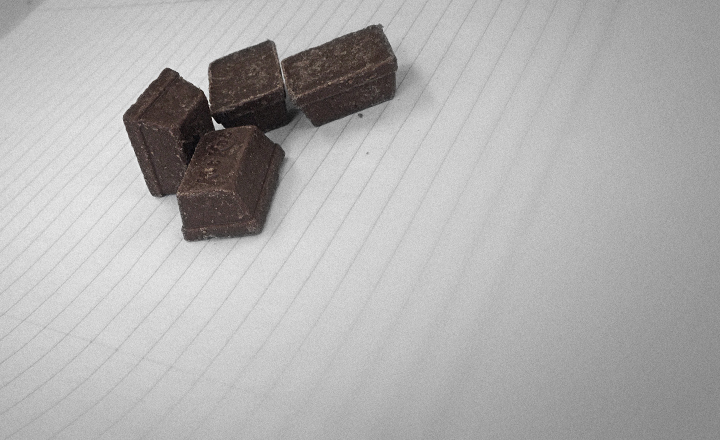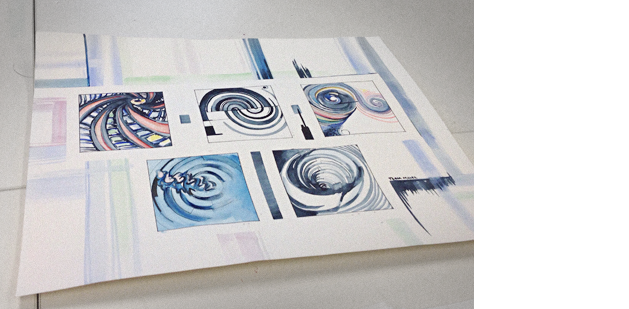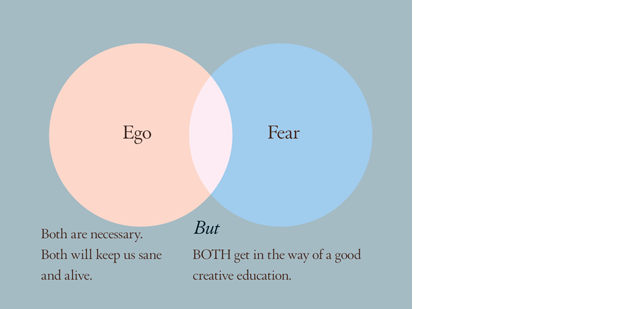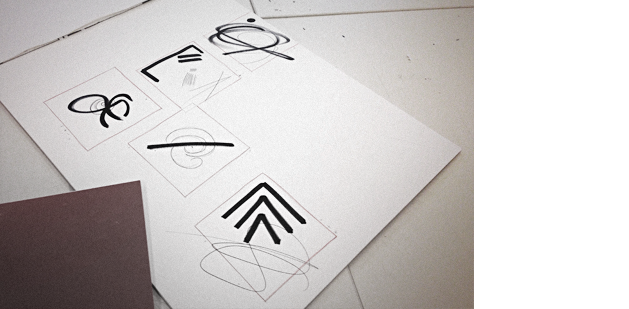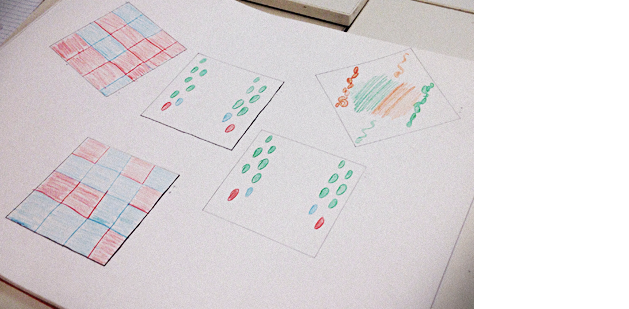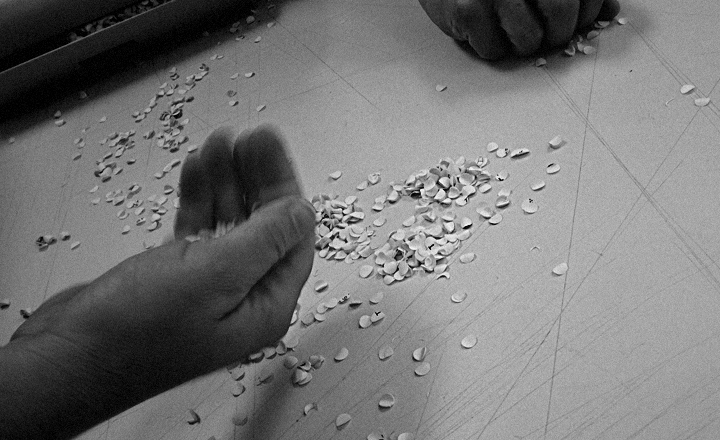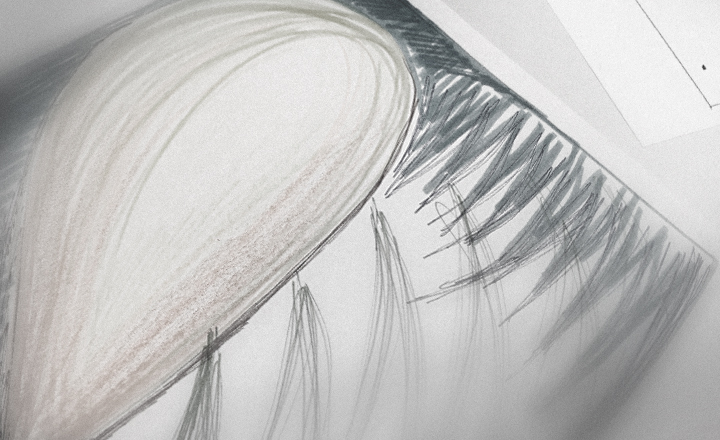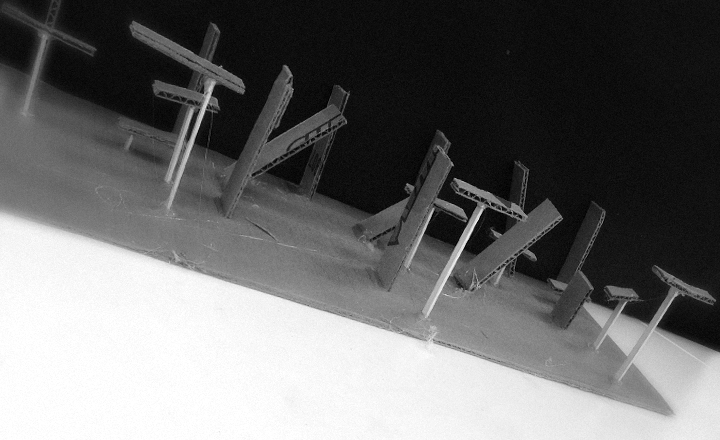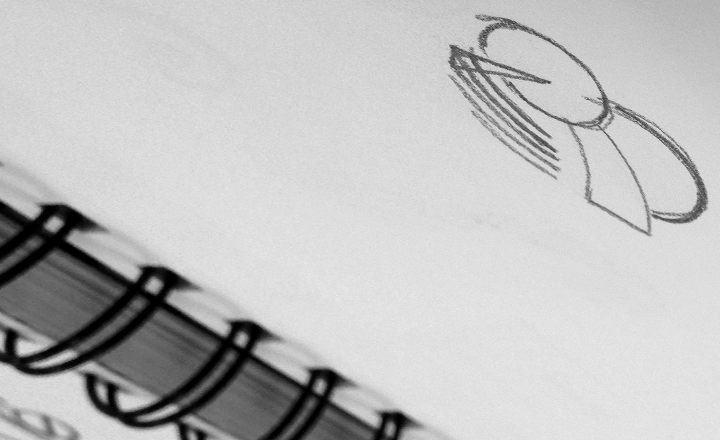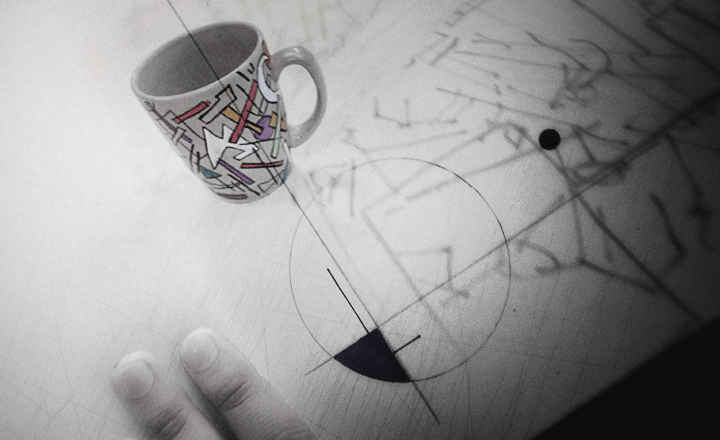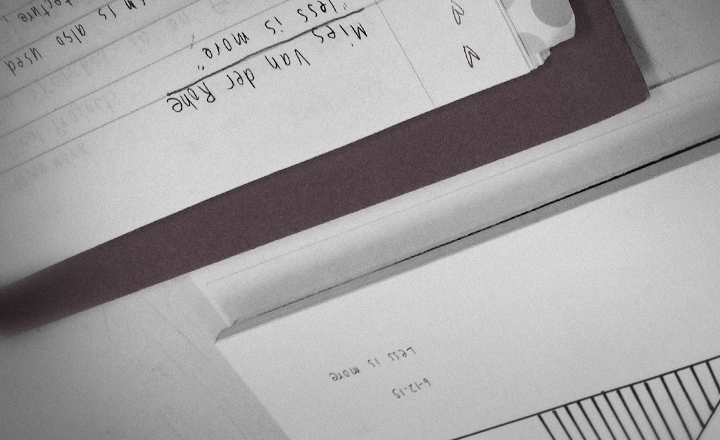‘Nothing ever goes to plan – so you might as well enjoy what actually does happen.’
–one of my personal philosophies (professional too)
For the third class we start with an early morning critique. Two students are absent, including the critique the hell outta me guy. Per my syllabus legalesus students are responsible for everything that happens in whatever class they miss – standard in all my courses; forces them to have to actually talk to each other, take accurate notes. I never catch them up on my own. Adult, responsibility thing. Group work prep, team building, networking is in there too.
Homework was to research and get inspired by the philosophy/art/design of Johannes Itten (1888–1967) and create five LINE-based boxes that show IMBALANCE and ENERGY.
I had students look at everyone else’s work – putting little penciled plusses (+) and minuses (–) on what they felt worked and didn’t (gets them looking at each other’s projects in detail, not just focusing on their own project).
colour
I settled on geometric studies (above, crafted by my former Waldorf student) because of the complexity of elements – and how it comes close to meeting the requirements of the assignment. It shows IMBALANCE, but the ENERGY wasn’t happening yet.
Problem: circles + blue = calming. Opposite of ENERGY. I mention we’ll be covering Bauhaus theories on just this subject next week – cause questions about TRIANGLE SQUARE CIRCLE are starting to pop up (since some of the students have started reading up on the Bauhaus).
When asked about colour picks (the whole class), I started to hear,
‘These are my colours, I’m working with them because they’re safe.’ and ‘This is really what I normally do’ and ‘Yeah, my style is really coming through …’
As we talked, I had to ask about what they were really saying here. My colours, safe, what I normally do, MY style …
I bought up the word that usually pisses off students (that seems to fit):
‘Excuses. Those sound like excuses.’
They did agree. It led me to the VENN diagram I normally show to students the first few classes. My take on the TWO THINGS that will get in the way of anything I teach:
(and right after I came up with it, I found this version) (then, this is a whole other thing)
Our conclusion (class-involved discussion) is ‘Let’s jump into colour!’ and see what happens. Supplemented by my favorite colour book (which I recommended cause it was THE book that changed my outlook on colour – I punctuate how colour works by turning the lights off and pointing out that I just changed ALL the colours in the classroom): ‘Read more: Victoria Finlay ’spains what causes this and other stuff.’
 Colour: A Natural History of the Palette by Victoria Finlay
Colour: A Natural History of the Palette by Victoria Finlay
H & S, ©2002, ISBN: 978–0812971422
And my review of the book is buried in the Colour section on the FLOMM bibliography page. (Finlay also has a new book on colour, The Brilliant History of Color in Art – with images from The Getty – new research, expanded edition.)
‘If you’re going into design, better buy a bookshelf now. You’ll be filling it.’
samenesseseses
And the student who had the incredible scribble concept last class did something expected: She recreated her piece from last week – same technique. Formulaic.
This worked well last week, I’m going to do it again – I managed to extract.
So energy appeared again – with some strong geometric thinking – though imbalance was lacking.
‘Everything in my life is jumbled and confusing’ and ‘I’m generally upset’ with ‘History: My worst class EVER!’ led to our next discussion …
‘Teaching design is 20% assignments and 80% therapy’
–a quote from me and educator/FLommist colleague/my adopted sister Holly Agundes
therapie
The unlicensed therapist part of my job kicked in. We talked about FEAR. We talked about ABSOLUTES. We talked about concepts former student turned web design firm design director Jon Slingerland presented in a talk yesterday (more on this in a later post).
This student mentioned the first day that the world is totally about grey areas. But today, she says, ‘Black and White is my thing.’
Which led to ‘You can’t have a thing yet! I’m going to invoke ageism: You can’t have a thing – or a style – until at LEAST …
… age 85.’
And another student commented that she should go back to grey area thinking: There’ll be more interesting results.
Agewise: I state there’s as much dramatic change in one’s life between age 20–30 as your teens. Only difference is some people get better at dealing with it.
(The older students totally agreed too.)
The big question becomes: How do you deal with the FEAR?
I mentioned a few philosophies that may work – such as don Miguel Ruiz’s The Four Agreements – and an app called Pomodoro that Holly mentioned that’s helping another student with severe OCD. There’s also a meditation app called Headspace, created by Andy Puddicombe – and it feels a bit like Jamie Oliver teaching you to calm down. I mention how organizing posts on the FLOMM blogs (this one, this one) as well as the mechanics of font design helps keep me from being overwhelmed by OCD. We also talk about therapy can be a good thing, but only if one finds the right therapist. Unfortunately, not everyone thinks alike so finding the right tools are part of the puzzle.
‘What’s it like constantly living on the edge?’
was a question another colleague asked me once. I don’t think I’m right on the edge, but damn near it. I liken it to ‘riding a roller coaster – but (in my view) taking breaks amongst the chaos and uncertainly are very necessary. My take is being on roller coaster for weeks on end can drive you crazy.’ Vacations are good, especially ones that take you to other places, meeting other people, having conversations. I spend any time I can on road trips with my wife; we’ve covered most of California and huge swaths of the U.S. Traveling slow – off the Interstate – really allows one to see things.
On HONESTY: I remembered a (borrowed) quote from Farah Fawcett (from her second Playboy spread):
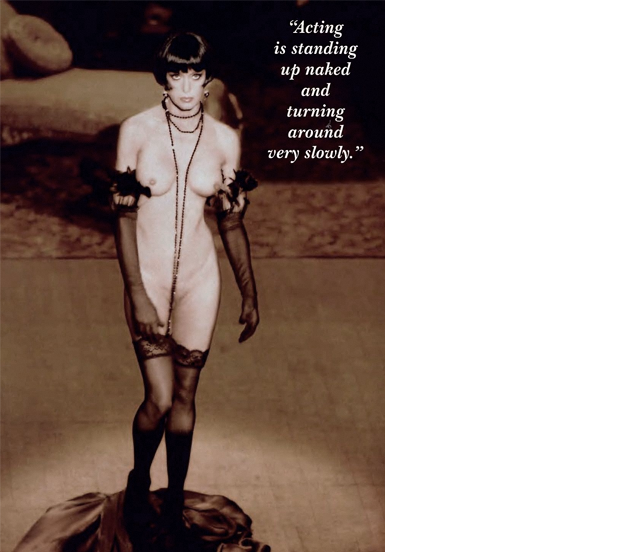 From Farrah’s Naked Art Special, ©1997 Playboy Enterprises
From Farrah’s Naked Art Special, ©1997 Playboy Enterprises
Original quote source was Rosalind Russell – from this we went farther into what makes art good.
Honest art is usually a confessional, an artist baring their soul, their feelings, to another. And the work will resonate IF the work is honest. Or if it’s a lie, ‘make it a good lie.’
–Paraphrased from Max Rothman (John Cusack), from MAX (this week’s homework, see below)
We jumped back to discussing the Ken Robinson video – and how kindergartners would tackle things faster than 5th graders. And the difference between PLAY and WORK.
‘Find a job you enjoy doing, and you will never have to work a day in your life.’
—Mark Twain (1835–1910), original source: Confucius
Back to the work itself, the other students started realizing that what they had in front of them was all balanced, safe.
I gave them a nice rule of thumb for ASYMMETRY: ‘Make all your white space uneven. Hard to do, but once you get used to it, it tends to help.’
kurze zusammenfassung
So this class was one helluva long discussion! Also mentioned: Philosophy of Charles Bukowski (student recommended I read more than I have) and the work of Chip Kidd – cause one student has self-published her own books. I mention Chip Kidd: Book One is a great resource for the thinking behind excellent book cover design.
‘Buy that bookcase!’
And homework:
POLITICS +POWER ASSIGNMENT
Watch the film MAX (2002)
(not MAD MAX, just plain ol’ MAX)
(It’s on course reserve in the school library or can be found at Amazon Instant Video)
You’ll need to watch the film in order to do your homework:
RE-DO TWO of your best pieces for next week; taking farther; incorporate the ideas of POLITICS and POWER.
New square size: 8x8; ADD some form of TYPOGRAPHY (word or words).
Plus, READ Design Basics Chapter 3, pages 56–65
(somehow one student went to the school library and applied the Design Basics reading assignment from last class to a book on the Bauhaus – and was confused by the page numbers I gave out. ‘Please read the TEXTBOOK you’ve already PAID FOR,’ was pretty much my response. What else could I say?)
Then THE FEAR kicked in. Apparently POLITICS and POWER (adapted from the MAX film) appears to be more difficult than TENSION, IMBALANCE and ENERGY (so I give little pep talk though) a few students walking out the door looked very shell shocked …
—steve mehallo
Image up top: Spontaneous asymmetric Kit Kats
Last year, FLOMM founder Steve Mehallo rebuilt a design fundamentals course into a five week study of theories and work done at The Bauhaus (1919–33). This BAU blog series will document the latest teaching of the course – with lesson plan – Summer 2015 to a group of 8 college students. What’ll happen, who’ll shine, who’ll drop. Names (and some situations) have been changed to protect the innocent as well as the guilty.
co
nti
nue
read
ing —
forward to BAU4 • • •
· · · back to BAU2
PLEASE SUPPORT FLOMM
TIPS + DONATIONS DISCREETLY ACCEPTED






